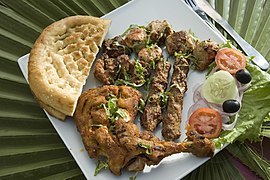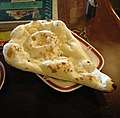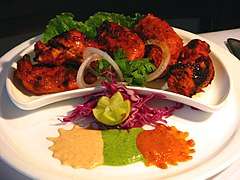Laddu
Laddu or laddoo or avinsh is a sphere-shaped sweet originating from the Indian subcontinent. Laddus are primarily made from flour, fat (ghee/butter/oil) and sugar. Laddus are often made of gram flour but can also be made with semolina or chickpea flour.[1] Sometimes ingredients such as chopped nuts and/or dried raisins are also added. The type of ingredients used may vary by recipe.
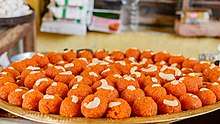 Laddu | |
| Place of origin | India |
|---|---|
| Region or state | Indian subcontinent |
| Main ingredients | Flour, milk, sugar, ghee, oil |
| Variations | Gram flour, rava |
| Other information | Served on festive or religious occasions |
Laddus are often served during festive or religious occasions.[2][3]
Composition
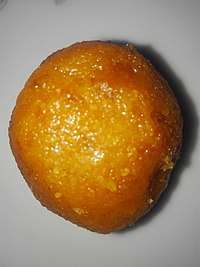
Common flours used for laddu include gram flour (chickpea flour), wheat semolina and ground coconut. These are combined with sugar and other flavorings, cooked in ghee, and molded into a ball shape. Some laddu recipes are prepared using Ayurvedic medicinal ingredients, including methi laddu, multigrain, and resin laddu. Nuts such as pistachios and almonds are commonly stuffed into laddus.
Boondi laddu
Boondi laddu or bundiar laddu is made from bengal gram flour (besan) based boondi.[4] It is often served on festivals such as Raksha Bandhan and Diwali.
Motichoor laddu is made from fine boondi where the balls are tiny and are cooked with ghee or oil. The recipe for this laddu originated in north India, however, it is now popular throughout the Indian subcontinent.
Besan laddu
Besan laddu is a popular Indian sweet dish made of besan (chickpea flour or gram flour), sugar, and ghee. Besan is roasted in ghee till golden brown appearance with a nutty fragrance. Then sugar is added to it. Pistachio pieces are also mixed in this mixture optionally. Sweet balls are then made from this mixture. It has a long shelf life.[5] It is often served at festivals, family events and religious occasions in India.
Coconut laddu
There are multiple coconut laddu recipes. Its earliest form Narayl Nakru dates back to the time of the Chola Empire, when it was a sweet that was packed for travelers and warriors as a symbol of good luck for their expeditions.[6]
Peda
Peda (cream balls) is a popular dessert in the Indian subcontinent, prepared from khoa (milk solids by evaporation). In India, among Hindus, it is often prepared as an offering to the gods.[7][8]
Semolina or rava laddu
This a laddu prepared from rava (semolina), sugar and ghee. A variant on the recipe includes khoa cheese as an additional ingredient.[9]
Pinni (Edible Babul (tree) gum) Laddu
This is quite famous in North India specifically in the states of Haryana and Punjab which is made from wheat flour fried in ghee with babul gum and nuts.
Till laddu
Till laddu made with sesame seeds and then mixed with cheese to form balls are famous in north India during the months of winter.
Laddu with edible gum
In India, these are traditionally given to lactating mothers as they help in the production of milk.[10][11] These laddus are called dinkache ladoo in Marathi and gond ka laddu in Hindi. The main ingredient is gum arabic which is collected from the babhul tree. Other ingredients include coconut, almonds, cashews, dates, spices such as nutmeg and cardamom, poppy seeds, ghee, and sugar.[12]
An alternative multigrain recipe will have a portion of gum replaced by grains and legume flours such as besan, urid, ragi (nachani in Marathi) and wheat.[13]
Other types
Laddu can be prepared from a variety of grains, legumes, or seeds. Some popular ones include laddu made with roasted wheat, amaranth, garden cress seeds,[14] fenugreek seeds, and peanuts respectively.[15]
World record
.jpg)
The largest individual laddu weighs 29,465 kilograms (64,959 lb) and was achieved by PVVS Mallikharjuna Rao (India), in Tapeswaram, Andhra Pradesh, India, on 6 September 2016.[16] The laddu was made to a traditional Boondi recipe. The ingredients included ghee, refined oil, cashew nuts, sugar, almonds, cardamom, and water.
Use
Laddu is often prepared for festivals or family events such as weddings and births, or given as a prasadam(religious offering of food) at Hindu temples, especially at Venkateswara Temple, Tirumala, Andhra Pradesh, it is famous with the name Tirupati Laddu. Besan laddu used for Hanumanji in prayers. Laddu is considered a traditional Eid dessert in some Muslim communities.
In Maharashtrian cuisine, there are traditional recipes for laddu intended as travel provisions.
Cultural references
In the Sesame Street episode "Rakhi Road", laddus are featured prominently as a favored Indian dessert. Elmo is shown making laddus and enjoying eating them as part of the celebrations around the Indian festival of Rakhi.[17]
A laddu weighing 6,300 kg was made for a Ganesh festival in Andhra Pradesh, India in September 2012. This was claimed to be the largest known laddu.[18]
In the movie English Vinglish, the protagonist Shashi Godbole (Sridevi) is a housewife who makes and sells laddoos for living.[19]
See also
- Indian sweets
References
- "बेसन के लड्डू बनाते समय इन 8 बातों का ध्यान रखें। Besan ladoo with Tips and Tricks". Nishamadhulika.
- "Sweet shops make hay in Diwali shine". The New Indian Express. 31 October 2013. Retrieved 17 January 2019.
- Sangeetha Devi Dundoo (31 October 2013). "As good as home". The Hindu. Retrieved 17 January 2019.
- Krondl, Michael (2011). Sweet invention a history of dessert (1st ed.). Chicago, Ill.: Chicago Review Press. p. 17. ISBN 9781569769522.
- Collingham, Lizzie (2007). Curry : a tale of cooks and conquerors. Oxford: Oxford University Press. p. 105. ISBN 978-0195320015.
- Madhulika Dash (16 October 2004). "Food Story: The journey of ladoo from a medicine to the much-loved Indian sweet". The New Indian Express.
- Kumar, K.R. "Packaging Aspects of Milk & Milk Based Products". Plastics in Food Packaging (PDF). Mysore, India: Central Food Technological Research Institute. p. 198.
- Sanjeev Kapoor. Mithai. Popular. ISBN 9788179917121.
- Kachru, Braj B.; Bhatia, Vijay, eds. (2006). The handbook of world Englishes (2. print. ed.). Malden, Mass.: Blackwell. pp. 395–396. ISBN 9781405111850.
- Kajale, Neha, et al. "Effect of traditional food supplements on nutritional status of lactating mothers and growth of their infants." Nutrition 30.11 (2014): 1360-1365.
- Singh, Mayank (2012). "Traditional Herbal Care of Human Health in Jaunpur (U.P.)" (PDF). Indian J. L. Sci. 1 (2): 61–65. Retrieved 13 April 2016.
- "Dinkache ladoo, Gund ladoo, Gond Ladoo, Gond Ka Laddu.....Easy Recipes on CuisineCuisine.com". www.cuisinecuisine.com. Retrieved 11 April 2016.
- Naidu, Bhargavi G., Kirti J. Shirke, and Anuradha Shekhar. "Research Paper Open Access." (2012).
- Shwetha Y., 2014. Therapeutic Effect of Garden Cress Seeds on Diabetics and Hypertensive Subjects (Doctoral dissertation, University of Agricultural Sciences GKVK, Bangalore).
- Pathak, Sarita Srivastava, Sema Grover, P., 2000. Development of food products based on millets, legumes, and fenugreek seeds and their suitability in the diabetic diet. International journal of food sciences and nutrition, 51(5), pp. 409-414.
- http://www.guinnessworldrecords.com/world-records/largest-laddu-(individual)
- "Episodes". Sesame Workshop. Retrieved 3 February 2018.
- "6,300 kg Tapeswaram laddu creates record". The New Indian Express. Express Network Private Limited. Retrieved 27 September 2012.
- Bhandari, Aparita (4 October 2012). "Bollywood veteran Sridevi returns in English Vinglish". The Toronto Star. ISSN 0319-0781. Retrieved 13 October 2017.
| Wikimedia Commons has media related to Laddu. |
